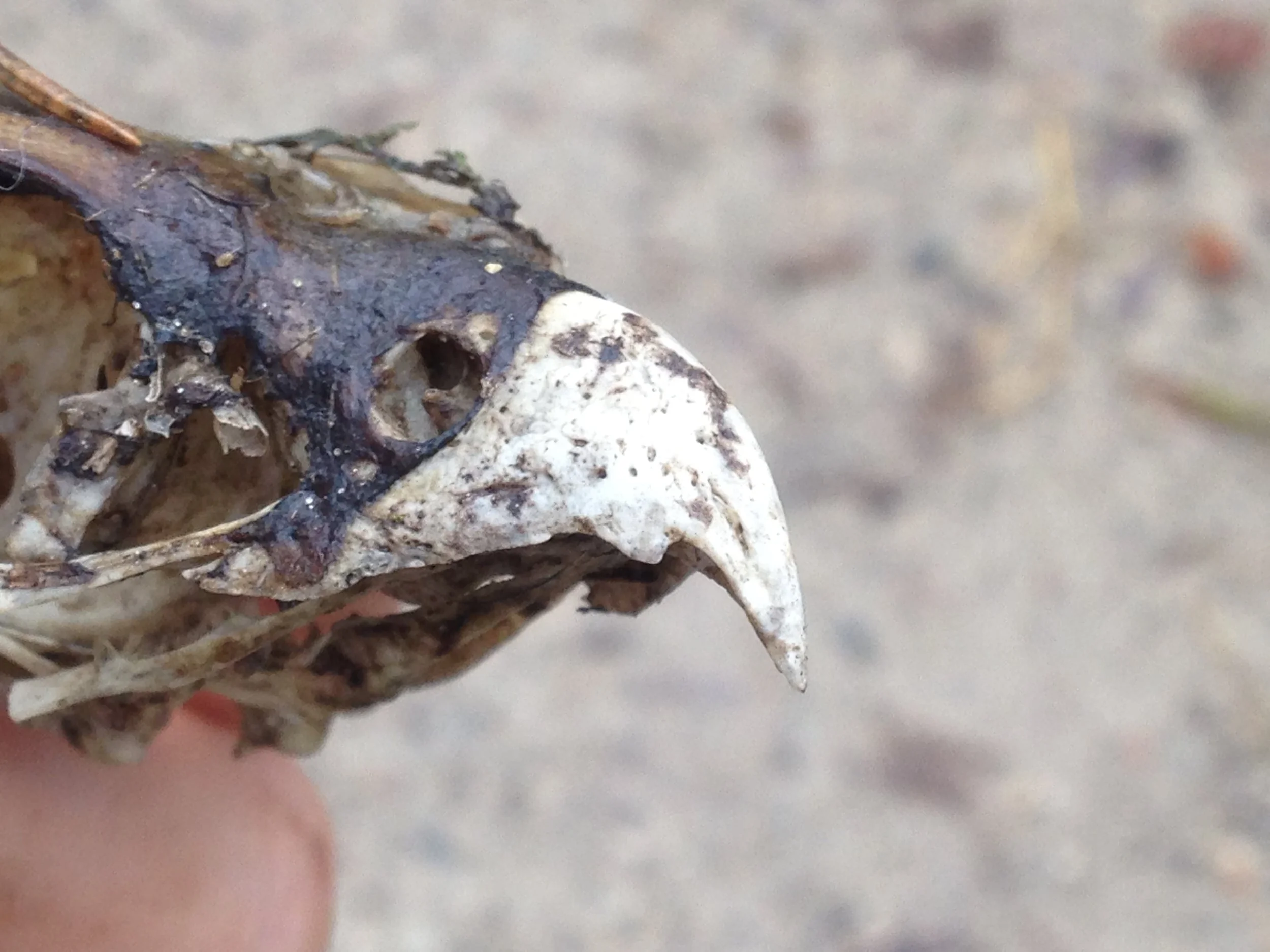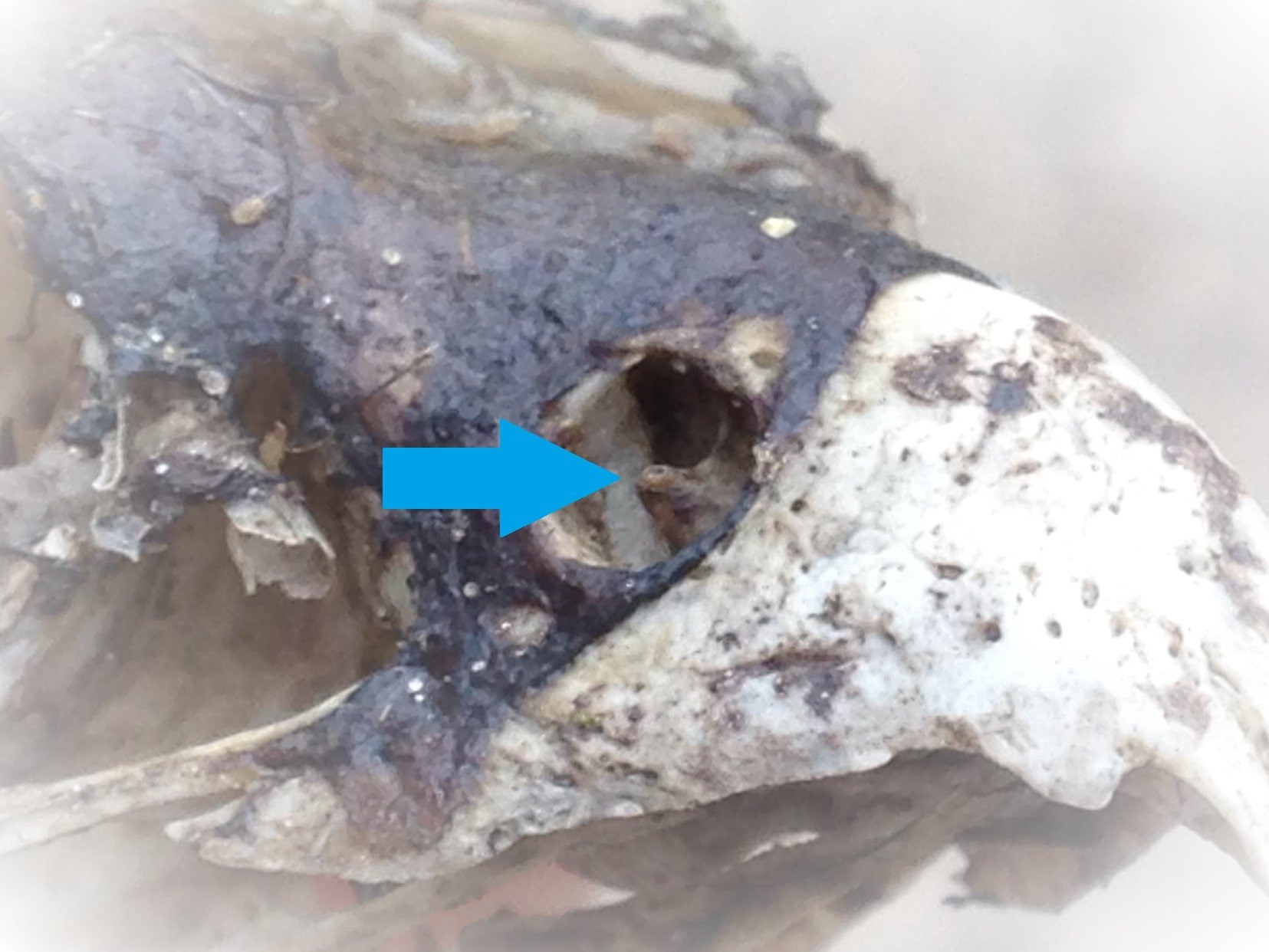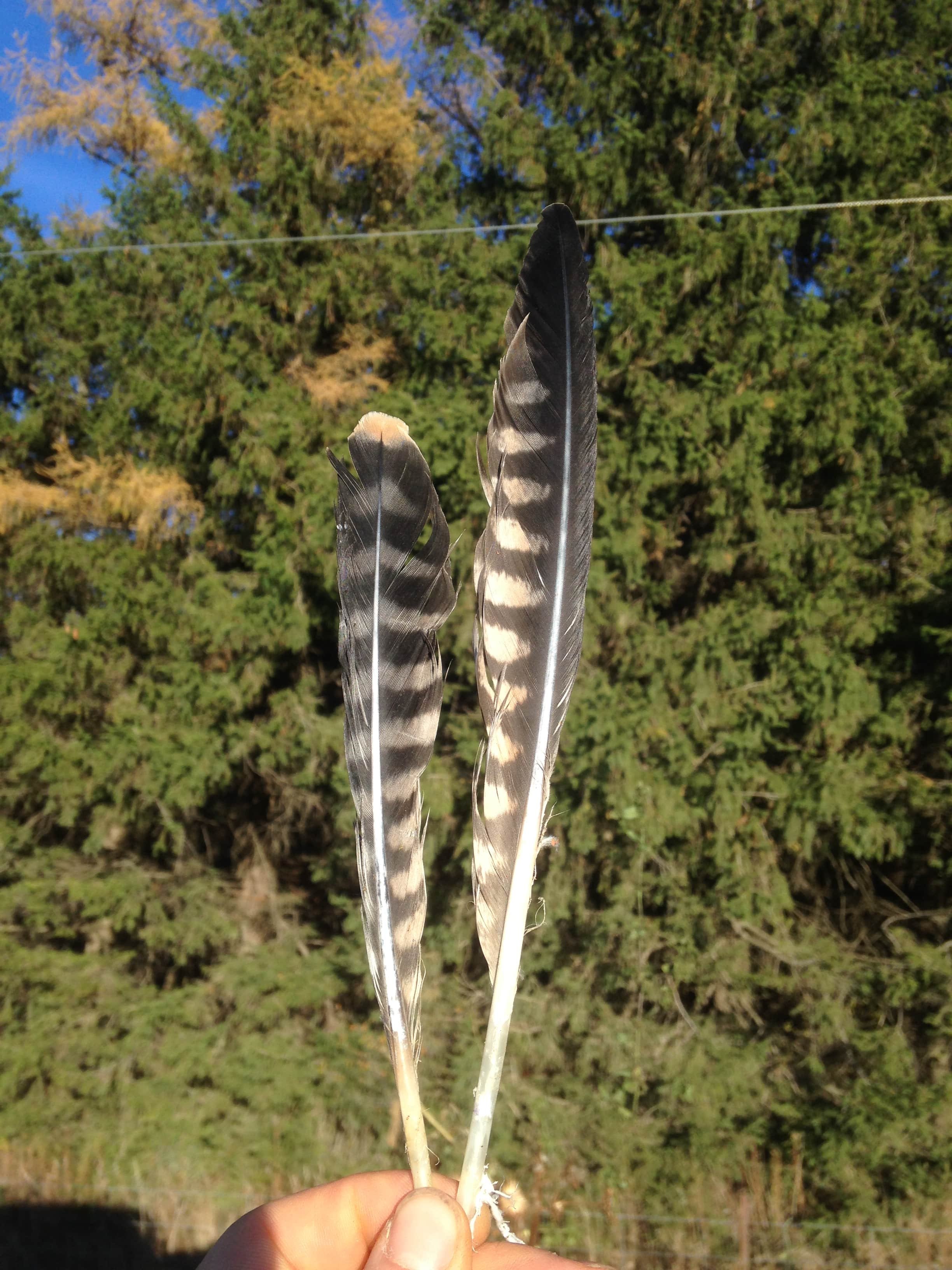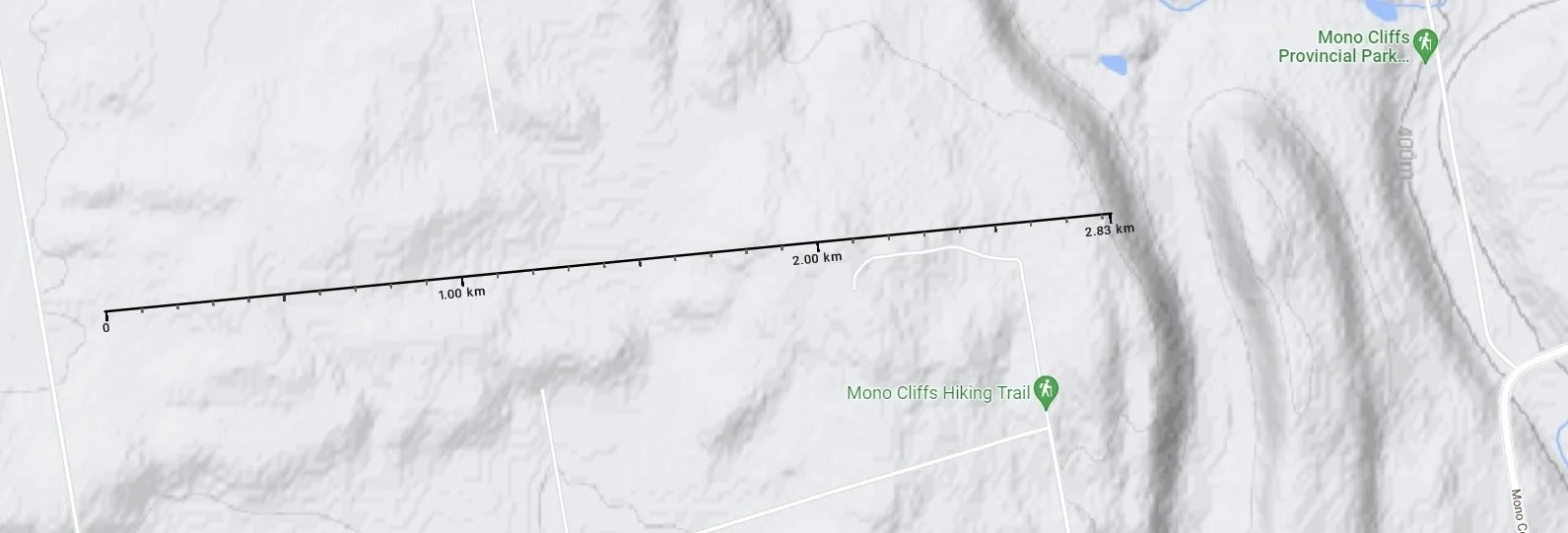Along came a skull…
On Saturday October 29th, two days before the episode on my inappropriate appropriation of a Great Horned Owl (Bubo virginianus) skull aired, I drove to Mono Tract, North of Orangeville here in Ontario to pick up my partner from a day of learning about and harvesting roots from various species. I wasn’t there while they were doing this. Instead I was off at the Boyne Valley, still a little further North, trailing White-tailed Deer (Odocoileus virginiana) and looking for fungi, but when I arrived at the forest I was met with excitement about a skull.
My friend Brier handed me a small brown bag with a excited story about how L.E. found the skull and some other remains of a bird in some moss within an old Spruce (Picea spp.) & Pine (Pinus spp.) plantation that is succeeding to a mixed wood. I opened the bag, distracted and not fully hearing all the details, but excitedly looking to take some photos of the skull. I asked a couple of clarifying questions to seek out some basic answers, but things didn’t seem certain. I heard that there were talons, feathers, and some bones remaining, that the remains seemed maybe a couple weeks old, but aside from some guesses there was i.d. on whose skull it was and how it got there.
During the conversation, Brier offered the skull to me. I have never taken a skull as a gift from another human before (I have never bought, traded, sold a skull either, but that is another blog post for the future). I wasn’t sure I should take it and I offered it back to Brier, but she declined and encouraged me. In retrospect, I am grateful she did because this particular skull has brought with it a lot of research and learning.
Unknown feathers. Short one is 21cm, the larger is 28cm. Found in an old Spruce plantation, "Mono Tract" near Orangeville.
At the end of the day, L.E. showed me a couple of the feathers so I could try and help sort out who it was. I pulled out Mark Elbroch and Eleanor Mark’s Bird Tracks and Sign and we looked through the back of the book for the section on feathers, but honestly I was left without any particular inclinations. I did not recognize the feathers nor the skull. It was all still a mystery to me.
When I got home I immediately posted photos of the feathers and skull on a messaging app for my work in hopes that someone could chime in with some guesses. My pals Matt and Miki wrote back individually suggesting Peregrine Falcon (Falco peregrinus) with Miki suggesting that the feathers look “falcony” and were also within appropriate size range, coming in at 21 cm for a shorter primary feather, and 28 cm for a longer primary. Miki also suggested that I look closer at the skull for a “tomial tooth”. What the hell was a “tomial tooth”?
I looked into it a little more and it turns out to be pretty cool. The tomial tooth isn’t actually a tooth. It is a small ridge and corresponding notch on the lower edge of the upper mandible (the cutting edge of the bill, sometimes called the tomium) on the bill on Falcons (Falco spp.), Shrikes (Lanius spp.), and Kites. It seems this information originates from Leslie Brown’s publication “Birds of Prey : Their Biology and Ecology” published in 1977, and all subsequent reports seem to either cite this book, or don’t refer to anything. My pal Tamara has also noted a structural similarity of the tomial tooth to the claw of a Polar Bear (Ursus maritimus) which enables the Bears to better grip slippery Pinnipeds. Does the tomial tooth enable these birds to better grip? Well, the Falcons have large talons which do a good job of gripping and don’t seem to need to grip much with their bills, but I am into keeping that possibility open.


Miki also told me to investigate the nostrils on the skull as there may be another sign that this was in fact a Peregrine Falcon skull. That sign was the tubercles (where the blue arrow is pointing in the 2nd slide above), which are the small bony cones in the nostrils which may act like a baffle to dampen and reduce the velocity of the wind coming into the nostril while the Falcon is flying at speeds of over 300 km/h! These tubercles were definitely present in the nostrils so this was yet another clue pointing to a Peregrine.
The confirmation (or as close as I could get to certain confirmation) came with the additional resource of the book Animal Skulls by Mark Elbroch. I checked out the images and measurements for Peregrines in hopes that everything would match, and from what I am able to access, they do. Elbroch notes that the average length of a Peregrine Falcon skull is 65.14 mm for males, and 67.42 for females (with samples for females coming in at 62.77 mm - 73.14 mm - the male sample size only included one specimen). The skull I was investigating was 69 mm long, which would err on the larger side (most birds of prey are sexually dimorphic with the females being the larger of the sexes). The average width of the Peregrine skulls Elbroch listed in his book were 38.70 for males, and 39.77 for females (37.22 mm - 41.32 mm for the females, and again only one male specimen was measured). The width on the specimen I had was 43 mm! This seemed to indicate that this was a female Peregrine Falcon and that she had kind of a fat head, which makes me wonder if more Northern subspecies and individual Peregrines are larger? This fits with biological principle of Bergmann’s Rule which says that within a taxonomic group the more North the individuals within this group are, the larger they will be.
There was a lingering question though. If this was a Peregrine Falcon, who usually nest around cliffs and mountainous areas, what were they doing at Mono Tract, in the middle of a Spruce and Pine forest? Would it make sense to be a Cooper’s Hawk (Accipiter cooperii) who prefer woodland habitats? Well, this one was was easy once I took the time to pan out and take a broader view of the situation.
When I looked at google maps to get a better sense of the landscape, I realized that Mono Tract is less than 3 km West of Mono Cliffs Provincial Park, home of pretty spectacular glacier scoured cliffs, so that could indicate a nesting area. But what were they doing in the woods? I didn’t get to see the site of the dead Peregrine, but I would assume that they were out hunting and perhaps met with a predator while tearing apart some prey on the forest floor. But this is only a guess. I have no idea what the remains looked like, what position they were in, what parts were missing, or any other important details which would give any more information.
Skull identification is such an interesting craft. It requires lots of curiosity, careful observation, often checking in with others either in person or through resources folks have developed. Sometimes part of the skull or the story of the skull is missing, but sometimes the story is shared through the skull itself based on the tracks and sign writ clear on the bone.
I am very grateful to the crew who found this skull, and to Brier for sharing this skull with me. I will take great care and honour the bones as best I know how. I am also very grateful to the Peregrine themselves, for bringing beauty and awe into the world, for nurturing the wild heart of the world, for the joy and mystery they inspired in all of us who have encountered their skull.
To learn more :
Peregrine Falcon entry at the Feather Atlas
Animal Skulls by Mark Elbroch, Stackpole Books, 2006.
Do bony tubercle inside the falcon nostril effect breathing during high speed diving?
Flow Phenomena in the Falcon Nose - an Interpretation Approach
Nose Dive : Falcons and Gannets
Bergmann’s Rule entry on wikipedia
What happened to this Gull? My previous Peregrine Falcon investigation



